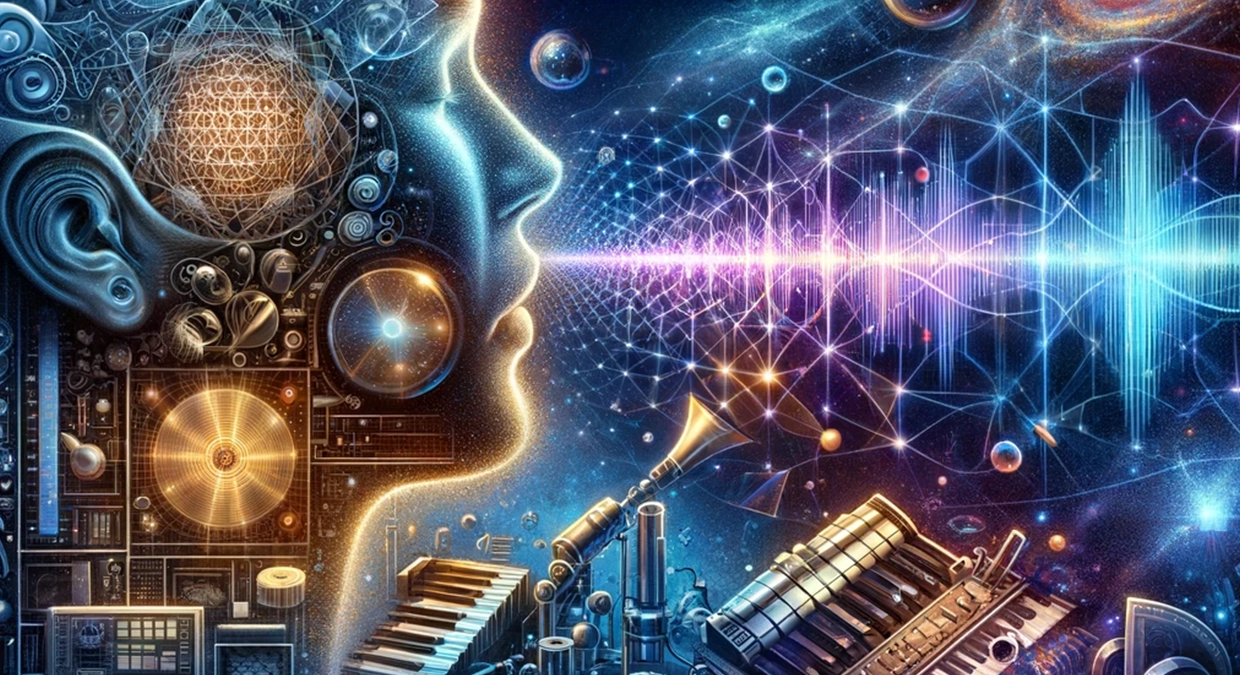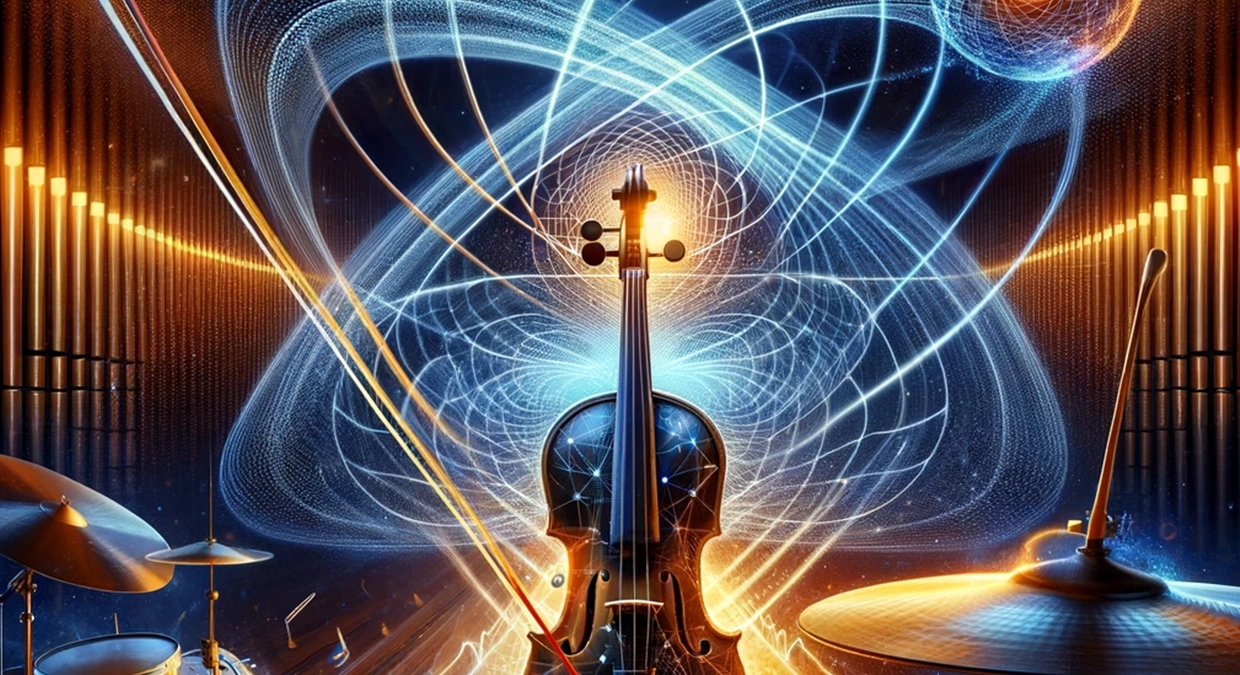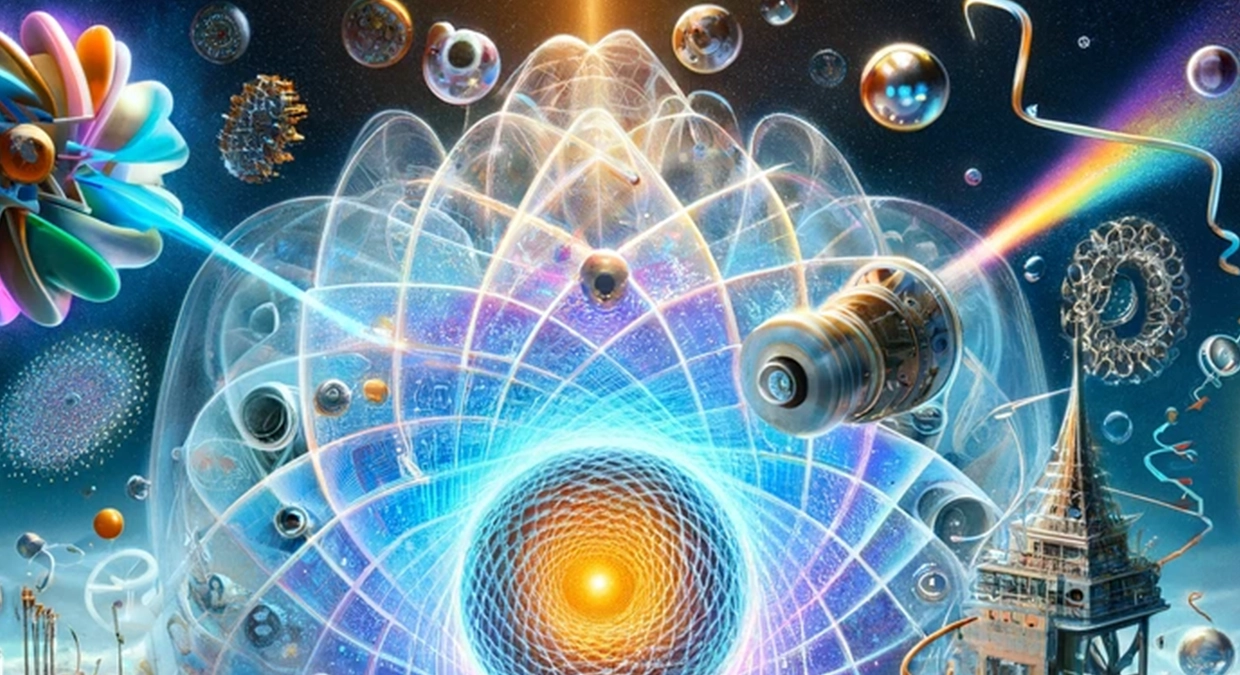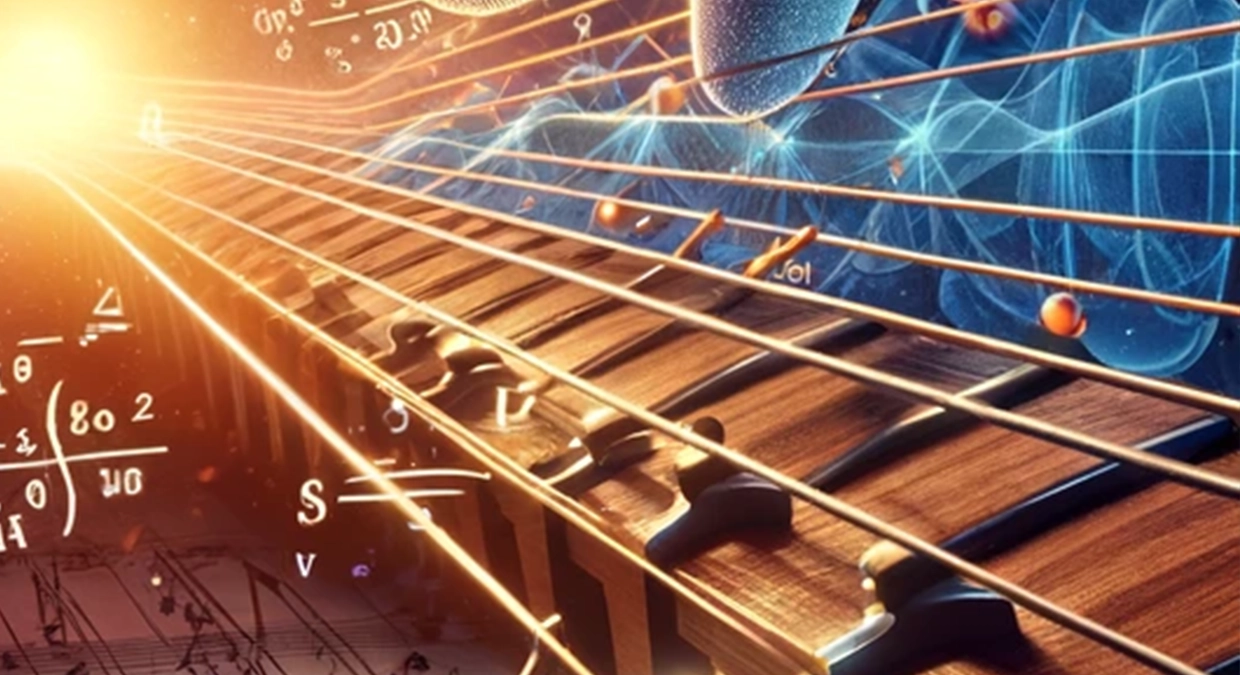Bridging Worlds
Brief overview of quantum optomechanics and its significance.
At the heart of the universe lies simplicity, where vibrations dictate the form and function of each atom. There is beauty wrapped around the chaos, and throughout it, there is motion.
Unsurprisingly, the microcosm of atoms, quarks, leptons, bosons, fermions, hadrons, mesons, baryons, gluons, neutrinos, electrons, protons, and neutrons relies on one of the first, and arguably the most significant fundamental scientific discoveries of the human species: movement. Vibration, movement, and balance.
Without vibration, nothing is, was, or ever could be. The precise universal properties that had to occur to allow vibration to occur is astounding in itself. Adding vibration to nothingness seems to create something.
Welcome to a new field, quantum optomechanics.
There is a delicate magic of symbiosis between light and matter at their most fundamental levels, revealing how even the smallest vibrations can unfold into the vastness of the cosmos. It's here, within the quiet whispers of quantum mechanics, that we find a curious bridge to travel; something far more familiar, yet equally profound. Sound is vibration, which, as it turns out, is what music is. Balanced frequencies create a mixture of sound to entice more motion, or, even emotion.
Quantum Optomechanics: Unveiling the Universe's Frequencies
From Whispering Particles to Cosmic Vibrations

Quantum optomechanics looks at existence by evaluating only the fundamentals. At its core, this discipline studies how light (photons) and mechanical systems (movable mirrors and membranes at the quantum level) interact. The macroscopic world we live in and the enigmatic quantum realm. Quantum optomechanics shines a light on the intricate vibrations between these particles and forces, revealing the subtle ways they influence one another. It's a field where precision is paramount, as scientists strive to measure and manipulate the quantum behavior of mechanical systems, pushing the boundaries of what we know about the universe's fundamental nature.
The recent breakthroughs in quantum optomechanics, particularly the development of ultralow noise cavities, mark a significant leap forward in our ability to observe and understand these quantum interactions. Imagine trying to listen to a whisper in the midst of a storm; the ultralow noise cavities act as an almost perfect silence, allowing the whispers of the quantum world to be heard more clearly than ever before. This advancement opens new doors for exploring the quantum mechanical forces at play in everything from the tiniest particles to the largest astronomical phenomena, drawing us closer to unlocking the mysteries of the universe.
But, this is a thought experiment, so we're going to dig into the parallels with music, where every note, every vibration, contributes to the harmony of the whole, suggesting a universe more interconnected and resonant than we ever imagined.
The Vibrational Bond: Physics Meets Music
Harmonizing Sound Waves with Quantum Worlds

The physics of music, at first glance, seems worlds apart from the quantum reality explored by physicists. Yet, both realms are fundamentally rooted in the exploration of vibrations and their propagation through different mediums. Music, in its essence, is the artful manipulation of sound waves, created by vibrations that travel through the air to our ears, where they are translated into the melodies and rhythms. These vibrations, whether emanating from the delicate strings of a violin or the resonant body of a drum, follow principles that echo the foundational laws of physics. It's a testament to the universality of vibration as a medium of energy transfer, spanning the gamut from the concert hall to the laboratory.
Turning our gaze to the study that serves as our guide, we find an intriguing parallel. The advancements in quantum optomechanics, particularly in controlling and measuring the minute vibrations of quantum systems, offer a unique perspective on understanding how energy moves and interacts at the subatomic level. Just as a musician might tune their instrument to achieve a perfect pitch, scientists employ ultralow noise cavities to fine-tune their observations of quantum phenomena. These developments not only deepen our comprehension of the quantum world but also hint at the underlying unity of all things vibrational. The exploration of quantum optomechanics, therefore, becomes a bridge between the abstract and the tangible, offering insights that resonate with the very chords of existence.
Unlocking Quantum Mysteries: The Study's Breakthrough
From Quantum Backaction to Clarity in Observation

In the heart of our exploration, we delve into the mechanics of the groundbreaking study, where the realms of quantum optomechanics and acoustics converge. This research, pioneering in its approach, has carved out new paths in our understanding of how quantum mechanics influences the physical world, particularly through the lens of ultralow noise cavities. These cavities, marvels of scientific innovation, act as arenas where the minutest vibrations and their quantum counterparts can be observed with unprecedented clarity. It's akin to clearing a fog that has long obscured our view, allowing us to observe the movement of photons and mechanical systems in a trance of pure physics. The implications of such observations are vast, stretching from potential technological breakthroughs to deeper philosophical musings about the nature of reality itself.
Through the precise and meticulous manipulation of these quantum systems, scientists are now able to measure the effects of quantum backaction - a phenomenon that was once only a theoretical curiosity. This backaction, where the act of measurement itself can alter the state of the system being measured, reveals the inherent interconnectedness of observer and observed, a principle that resonates deeply within the quantum world. The study's ability to control and reduce the noise that typically interferes with quantum measurements opens up new avenues for exploring the fundamental forces that govern the universe.
It's a step closer to a world where the quantum and the classical realms no longer exist in isolation but are understood as part of a cohesive, interconnected whole, offering a new lens through which to view the symphony of the cosmos.
Harmonic Resonance: The Mathematics of Music and Quantum Mechanics
Deciphering Musical Vibrations Through Quantum Insights

As we translate the quantum mechanical insights gleaned from the study into the realm of music, we embark on a mathematical journey that bridges the microscopic with the musical. Music, in its essence, is a rich tapestry of frequencies and rhythms, each note a vibration that resonates with the human spirit. The study's revelations about ultralow noise levels and precise quantum measurements offer a novel perspective on how we might analyze and understand these musical vibrations. By applying the mathematical principles underpinning quantum optomechanics, we can start to see patterns and relationships that were previously obscured by the limitations of classical physics.
This intersection of quantum physics and music theory opens up a fascinating dialogue about the nature of sound and resonance. For instance, the concept of soft-clamping and its effect on reducing mechanical dissipation in quantum systems mirrors the way a musician might manipulate the tension of a string to alter its tonal quality. The mathematical frameworks used to describe quantum interactions can similarly be adapted to explore the harmonic structures and resonance phenomena in music, offering insights into why certain chords or progressions evoke deep emotional responses. As we continue to unravel the mathematical underpinnings of music through the lens of quantum mechanics, we pave the way for a deeper appreciation and understanding of the universal language of music, revealing the hidden connections that unite the sciences and the arts.
Quantum Playlists: Unveiling the Universe's Echoes in Music
From Cosmic Sequences to Emotional Resonance
Music has the profound ability to mirror the universe's vastness and intricacy, resonating with the cosmic sequences that dictate the dance of particles and celestial bodies alike. This section explores the conceptual creation of "Quantum Playlists," a curated collection of musical pieces that encapsulate the essence of quantum phenomena and the emotional resonance they evoke. Each selection aims to harmonize the abstract principles of quantum mechanics with the tangible experience of musical expression, creating a bridge between the listener and the mysteries of the cosmos.
"The Entangled Symphony" - A piece inspired by the phenomenon of quantum entanglement, where interconnected notes and harmonies reflect the inseparable relationships between entangled particles, mirroring their simultaneous existence in multiple states.
"Schrödinger's Opus" - An experimental composition that plays with the concept of superposition, offering listeners different layers of music that coexist yet are heard distinctly, much like the cat in Schrödinger's thought experiment.
"Harmonics of the Vacuum" - A track that delves into the vacuum fluctuation of quantum fields, translating the spontaneous creation and annihilation of particles into fleeting musical motifs that appear and disappear within the composition.
"The Quantum Lattice" - Inspired by the lattice structure of solid-state physics, this piece utilizes repetitive motifs to represent the periodic potential that electrons encounter in a crystalline lattice, evolving into complex rhythmic patterns that mimic the behavior of condensed matter systems.
"Waves of Probability" - Drawing from the probabilistic nature of quantum mechanics, this composition explores the uncertainty and indeterminacy of quantum states through improvisational sections, where musicians navigate through scales and modes in a free-form manner, embodying the wave function's probabilistic essence.
"The Cosmic Microwave Background" - A soothing ambient piece that sonically interprets the cosmic microwave background radiation, the afterglow of the Big Bang, translating its uniformity and slight fluctuations into a soundscape that envelops the listener in the echoes of the universe's infancy.
Future Harmonies
Where Science Meets Art
As we venture into the final act of our exploration, "Future Harmonies: Where Science Meets Art," we stand at the crossroads of possibility and imagination. This section delves into the implications of our journey through quantum optomechanics and its symphonic parallel in music, envisioning a future where these realms not only intersect but flourish together, creating new paradigms of understanding and creativity.
Exploring the Interdisciplinary Crescendo
The fusion of quantum physics and music heralds a new era of innovation in both fields. For music creation and appreciation, the precise manipulation of sound at the quantum level could lead to revolutionary instruments and composition techniques, offering artists an unprecedented palette of vibrational colors. Imagine a guitar that harnesses quantum properties to produce sounds with a depth and resonance beyond our current comprehension, or a piano that plays with the harmonic intricacies of the universe itself.
- Potential Technological Innovations in Music Inspired by Quantum Research:
- Quantum Harmonic Oscillators for Richer Sounds
- Non-linear Sound Synthesis Based on Quantum Algorithms
- Enhanced Acoustic Materials with Quantum Damping Properties
The realm of scientific exploration also stands to gain immensely from this interdisciplinary melding. By applying musical theory to quantum systems, researchers can develop new models to understand complex phenomena, such as quantum entanglement and superposition, through the intuitive lens of harmony and resonance.
- Speculating on Future Experiments or Studies:
- Analyzing Quantum Entanglement Using Musical Harmonics
- The Impact of Sound Waves on Quantum State Transitions
- Exploring the Quantum Effects of Musical Frequencies on Matter
This confluence of science and art not only broadens our horizons but deepens our connection to the cosmos, reminding us that at the heart of all discovery lies the quest for harmony—be it in the notes of a symphony or the particles of light. As we embrace these future harmonies, where science meets art, we unlock new doors to understanding, creativity, and the endless dance of the universe.
By forging ahead with open minds and collaborative spirits, we stand on the brink of untold discoveries that promise to enrich both our scientific knowledge and our cultural heritage. In this symphony of the quantum and the melodic, every note, every particle, plays a crucial role in the grand composition of existence, inviting us all to listen, learn, and marvel at the music of the spheres.
Conclusion: The Universal Language of Vibration
Our exploration has taken us from the quantum to the cosmic, revealing the intricate symphony that underpins existence itself. In this journey, we've seen how the principles of quantum optomechanics resonate within the fabric of music, suggesting that the universe's most fundamental forces and the music that moves us are but different expressions of the same vibrational truth. This revelation not only deepens our understanding of both fields but also illuminates the interconnectedness of all things, from the smallest particle to the grandest galaxy.
Reflecting on the Harmony Between Quantum Physics and Music
The article has woven together the threads of scientific inquiry and artistic expression, demonstrating that the quest for knowledge and the pursuit of beauty are two sides of the same coin. By exploring the vibrational links between quantum mechanics and music, we've uncovered a rich tapestry of connections that transcend disciplinary boundaries, offering us a glimpse into the unified nature of reality.
Envisioning a Future of Interdisciplinary Exploration
As we look to the future, the potential for further discovery at the nexus of quantum physics and music holds immense promise. The collaborative efforts of scientists, musicians, and artists, fueled by curiosity and creativity, are bound to unveil new dimensions of understanding and expression. The journey ahead is as boundless as the universe itself, with every exploration and composition contributing to the ongoing symphony of existence.
In closing, our foray into the quantum harmonies of the universe and the music that echoes through our lives serves as a reminder of the profound connections that bind us all. It's a testament to the power of inquiry and imagination to reveal the wonders of the cosmos, inspiring us to listen closely to the music of the spheres and to continue our quest for understanding in the grand orchestra of the universe.
Huang, Guanhao, Alberto Beccari, Nils J. Engelsen, and Tobias J. Kippenberg. "Room-temperature quantum optomechanics using an ultralow noise cavity." Nature, vol. 626, 2024, pp. 512–516, https://doi.org/10.1038/s41586-023-06997-3. Accessed 4 Mar. 2024.